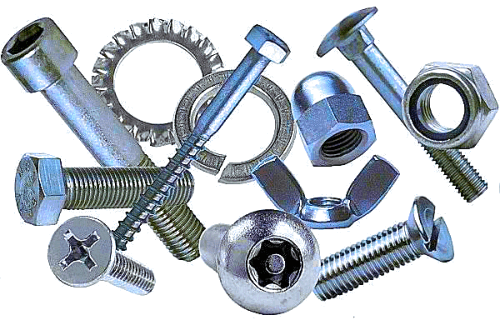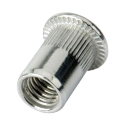Description
Nuts and Bolts are available in a wide variety of sizes, types of screw thread, shapes of head and materials to provide a very commonly used means of fastening components together such that they can be removed if needed.
A screw thread is one of the Basic Machines comprising a small thread cross-section wrapped around a cylinder as a Helix - which in itself can be simulated by wrapping a triangle around a cylinder. It follows that coarser threads have bigger thread cross sections and are therefore stronger, especially in softer materials, but fine threads follow the Helix traced by a more Acute angled triangle and grip tighter because they are a thinner Wedge or Inclined Plane - (e.g. the cylinder head Studs of a high revving engine may have fine threads at the top to resist vibration but coarse threads where they screw into the soft aluminium crankcase).
Machine Screws are very similar to Bolts except that, in general, Bolts have a plain section of shank below the head whereas Machine Screws are threaded right up to the head.
Sizes are now most commonly standardised in terms of their diameter in millimetres (e.g. a 10mm bolt has an external diameter of 10mm) although British Association (B.A.) threads may still occasionally be found in the smaller sizes of screws. Older, now largely obsolete, standards include British Standard Whitworth (i.e. B.S.W.; B.S.F.; B.S.C. and B.S.B.), British Standard Pipe (or B.S.P. in which the size number was originally based on the inner diameter of a steel tube for which the external thread was intended), and the American Unified Thread Standard (i.e. U.N.C. and U.N.F.) - which are still in use in USA and Canada although there is movement towards the increasingly universal ISO Metric standard.
Bolt and Screw Head Shapes
| Hexagonal
|
These six-sided headed bolts and screws are now the most common in general use. Most Spanners and Sockets are designed to work with Hexagonal Nuts and Bolts
|
|
| Square
|
These were more common before modern manufacturing techniques made hexagonal bolts and screws cost effective and hence preferred. They are still available and tend to be used for the more rugged applications.
|
|
| Round
|
Round head machine screws provide a smooth finish less likely to snag loose clothing for example. Originally, all screws of all types had Slot Heads for use with a standard flat bladed Screwdriver but Phillips and Pozidrive type heads are now more common together with Socket Head types and various Tamper Resistant designs.
|
|
| Cheese Head
|
Machine Screws with a cylindrical head of height approximately half the head diameter. They are a traditional screw used in precision work and, like Cap Screws, they can be sunk below the surface of the material in a Counterbored hole.
|
|
| Countersunk
|
Abbreviated to Csk.Hd., these bolts and screws have a cone shaped head which allow them to sit within a Countersunk hole such that they can finish flush with the surface of the material.
|
|
| Wing Bolts and Thumbscrews
|
Designed to be easily tightened and undone using bare hands only and are suitable for components which have to be removed or replaced regularly.
|
|
| Coach Bolts (aka Carriage Bolts)
|
These are commonly used for bolting timber structures together. They have a square shank under the head which jams inside the drilled hole allowing them to be tightened from one side only. Traditionally combined with large flat washers and square nuts but others can be used.
|
|
| Roofing Bolts
|
Similar in appearance to Coach Bolts except they have Slotted Heads for use with a standard flat bladed Screwdriver and are threaded for their full length instead of having a plain shank under the head.
|
|
Cap Screws
Grub Screws
| Grub Screws (aka Set Screws)
|
These headless screws are commonly used for holding components in place on rotating shafts for example. Originally with a Slot Head for use with a flat blade Screwdriver, the Socket Head or Allen Screw versions are now preferred
|
|
Types of Nut
| Hexagonal
|
Their six-sided shape allows spanners and wrenches to be used with them in relatively confined spaces.
|
|
| Square
|
Most commonly used for heavier construction work and in conjunction with Square Headed Bolts.
|
|
| Wing Nut
|
Designed to be easily tightened and undone using bare hands only so are suitable for components which have to be removed or replaced regularly.
|
|
| Domed Nut
|
These are used to provide a better and smoother finish where a thread projects beyond a component surface.
|
|
| Lock Nuts
|
Although any two nuts can be tightened together on one thread, purpose made Locking Nuts are usually half the thickness of standard nuts. More specialised Locking Nuts are also available and where even more security is required Positive Locking methods such as Safety Wire can be used.
|
|
| Slot Head or Castellated
|
These have slots across the top of the nut which line up with a hole drilled in the bar or threaded bolt and a pin, clip or safety wire is passed through to prevent the nut coming loose.
|
|
| Locking Nuts
|
‘Aerotight’ and ‘Nyloc’ are the tradenames of two types of commonly used specialised locking nuts. ‘Aerotight’ rely on the top of the thread being slightly distorted. They can be re-used several times and will withstand higher temperatures than ‘Nyloc’ nuts, which rely on a plastics insert to grip the thread.
|
|
| Serrated Flange Nut
|
These have a built-in flange with grips cut into its surface which bind against the component when tightened to lessen the chance of the nut coming loose.
|
|
Washers
| Plain
|
Used to spread the load of a nut when tightened down on to it.
|
|
| Spring
|
Available in various designs, their purpose is to resist loosening of the nut.
|
|
| Repair (aka ‘Penny Washers’)
|
Similar to Plain Washers but a larger diameter in relation to the bore size
|
|
| Square
|
Used for fencing and heavier construction work often in conjunction with Coach Bolts and Screws or Roofing Bolts for example.
|
|
| Tab
|
These are thin washers with an additional ‘tab’ added, which can be used to make electrical connection or can be bent over to create a Positive Locking Device
|
|
Studs
| Studs
|
These can be made from threaded Bar Stock or purpose made - sometimes with a different thread at each end (a coarse thread at one end for entry into a material coupled with a fine thread at the other end for greater vibration resistance).
|
|
| Screw Stud
|
Variously known as Hanger Screws or Dowel Screws, these studs have a screw thread at one end and a wood screw at the other to faciliate the task of joining wood to components of various materials.
|
|
Threaded Inserts
| Rivet Nut
|
These provide a means of inserting a threaded hole into thin sheet materials. They are first screwed on to an adapter, on Mandrel then fixed in a similar manner to 'Pop' Rivets
|
|
| Threaded Inserts
|
Typically these have a very coarse external thread to screw into a pre-drilled hole in timber and an internal thread to receive a bolt or stud. Others have a roughened surface and are pressed into a tight fitting hole - or sometimes glued into place.
|
|
| Tee Nut Insert
|
Suitable for use with timber sheet and board material, these have sharp prongs which bite into the timber surface as bolts are tightened from the opposite side
|
|
| Screw Anchor
|
Once inserted into a pre-drilled hole, tightening a bolt compresses the anchor tube such that it grips the material.
|
|
Eye Bolts
| Eye Bolt
|
Often used in fencing applications or typically where wire stay ropes are to be attached. Commonly available Galvanised (and also in Stainless Steel especially for marine applications).
Safety Point!
They must not be confused with Lifting Eyes (see below) because they are not designed to carry heavy loads.
|
|
| Lifting Eye
|
These are designed to carry heavy equipment with capacities (i.e. WLL - Working Load Limit) from 95kg to 30 tonnes dependant on model types. IIlustrated is a Dynamo Bolt which is traditionally used to move equipment such as large electric motors and dynamos but they are suitable only for straight vertical lifts. Collared Eyebolts are similar but have a larger collar and a stronger ‘eye’ so they can be used for lifting both vertically and at an angle.
|
|
Masonry Fixings
| Rawlbolt Anchors
|
General purpose expanding shield anchor for use in brick, block, concrete or stone and available with either a bolt or a projecting stud.
|
|
| Rawlbolt Hook and Eye
|
Hook or Eye shield anchors suitable for temporary or permanent anchorage in brick, block, concrete or stone.
Safety Point!
Must not be used for safety harness applications or for lifting where a shock load could be applied.
|
|





































































